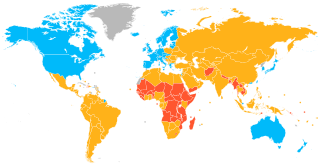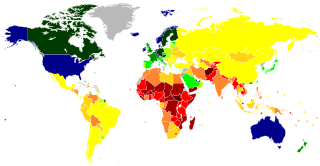
Gross domestic product (GDP) is a monetary measure of the market value of all the final goods and services produced and rendered in a specific time period by a country or countries. GDP is more often used by the government of a single country to measure its economic health. Due to its complex and subjective nature, this measure is often revised before being considered a reliable indicator.

Per capita income (PCI) or average income measures the average income earned per person in a given area in a specified year.
A variety of measures of national income and output are used in economics to estimate total economic activity in a country or region, including gross domestic product (GDP), gross national product (GNP), net national income (NNI), and adjusted national income. All are specially concerned with counting the total amount of goods and services produced within the economy and by various sectors. The boundary is usually defined by geography or citizenship, and it is also defined as the total income of the nation and also restrict the goods and services that are counted. For instance, some measures count only goods & services that are exchanged for money, excluding bartered goods, while other measures may attempt to include bartered goods by imputing monetary values to them.

A developed country, or high-income country, is a sovereign state that has a high quality of life, developed economy, and advanced technological infrastructure relative to other less industrialized nations. Most commonly, the criteria for evaluating the degree of economic development are the gross domestic product (GDP), gross national product (GNP), the per capita income, level of industrialization, amount of widespread infrastructure and general standard of living. Which criteria are to be used and which countries can be classified as being developed are subjects of debate. Different definitions of developed countries are provided by the International Monetary Fund and the World Bank; moreover, HDI ranking is used to reflect the composite index of life expectancy, education, and income per capita. Another commonly used measure of a developed country is the threshold of GDP (PPP) per capita of at least US$22,000. In 2023, 40 countries fit all four criteria, while an additional 15 countries fit three out of four.

The Human Development Index (HDI) is a statistical composite index of life expectancy, education, and per capita income indicators, which is used to rank countries into four tiers of human development. A country scores a higher level of HDI when the lifespan is higher, the education level is higher, and the gross national income GNI (PPP) per capita is higher. It was developed by Pakistani economist Mahbub ul-Haq and was further used to measure a country's development by the United Nations Development Programme (UNDP)'s Human Development Report Office.

Lists of countries by GDP per capita list the countries or territories in the world by their gross domestic product (GDP) per capita. The lists may be based on nominal or purchasing power parity GDP. Gross national income (GNI) per capita accounts for inflows and outflows of foreign capital. Income inequality metrics measure the distribution of income between rich and poor.

The gross national income (GNI), previously known as gross national product (GNP), is the total domestic and foreign output claimed by residents of a country, consisting of gross domestic product (GDP), plus factor incomes earned by foreign residents, minus income earned in the domestic economy by nonresidents.
The median income is the income amount that divides a population into two equally-sized groups, half having an income above that amount, and half having an income below that amount. It may differ from the mean income. Both of these are ways of understanding income distribution.
Household income is a measure of the combined incomes of all people sharing a particular household or place of residence. It includes every form of income, e.g., salaries and wages, retirement income, near cash government transfers like food stamps, and investment gains.

A high-income economy is defined by the World Bank as a country with a gross national income per capita of US$13,845 or more in 2022, calculated using the Atlas method. While the term "high-income" is often used interchangeably with "First World" and "developed country," the technical definitions of these terms differ. The term "first world" commonly refers to countries that aligned themselves with the U.S. and NATO during the Cold War. Several institutions, such as the Central Intelligence Agency (CIA) or International Monetary Fund (IMF), take factors other than high per capita income into account when classifying countries as "developed" or "advanced economies." According to the United Nations, for example, some high-income countries may also be developing countries. The GCC countries, for example, are classified as developing high-income countries. Thus, a high-income country may be classified as either developed or developing. Although Vatican City is a sovereign state, it is not classified by the World Bank under this definition.






